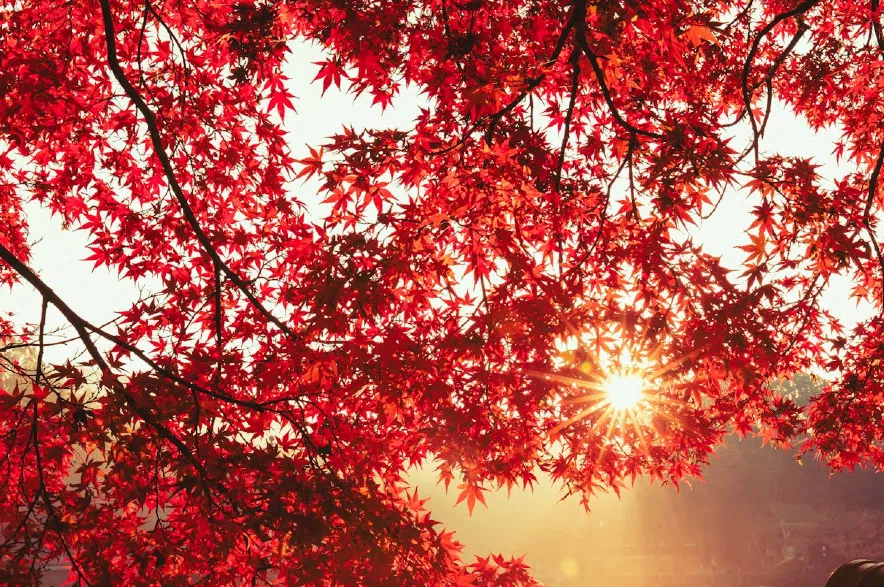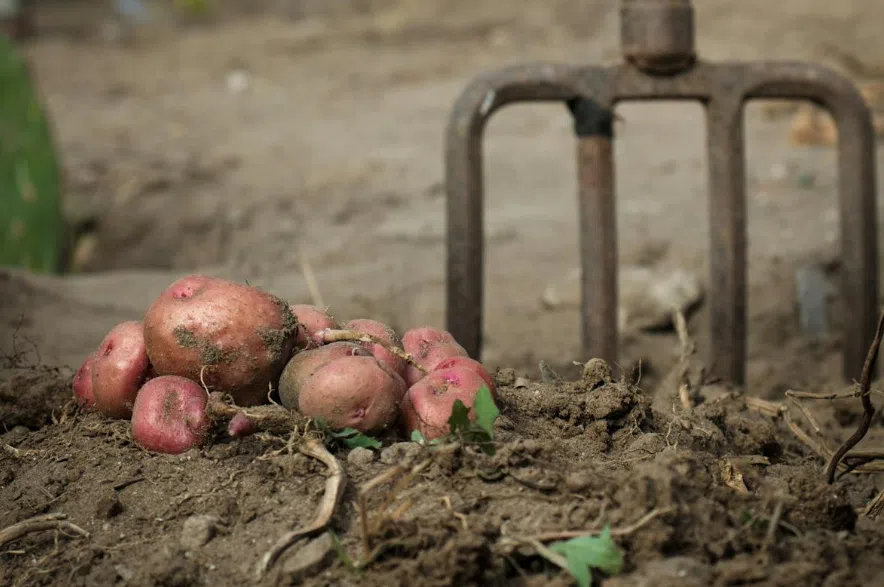Jill and Rick Van Duyvendyk answer all your gardening questions in Garden Talk on 650 CKOM and 980 CJME every Sunday morning from 9 a.m. to 11 a.m.
Here is a selection of questions and answers from the Oct. 20 show.
Q: What variety of maple trees hardy in Saskatchewan get red leaves in the fall?
A: Hot Wings and Amur maples turn nice orange-red in the fall. Not brilliant red like Autumn Blaze, which doesn’t really work out in the country here but will work in the city. Red rocket is a more upright, narrow variety that is flame red, and there’s Flame Amur, Ruby Slippers Amur — there’s a bunch of Amur maples, and any of them do well.
There is a few Freemen type of maple trees that that just won’t work well here — there’s one called Northwood that doesn’t do very well here at all — you get a bad winter and it dies. There are also some sugar maples like Sienna Glenn that do OK, and they’re more of an orange-red.
Q: How do I protect a young apricot tree in a south facing yard in Regina?
A: If it’s in the city, it should be okay. If it’s out in the country, then you want to put just almost like a windbreaker on the branches by wrapping them with burlap to stop the wind drying out the buds. Freeze-thaw, freeze-thaw is what the problem is mostly.
The country is tougher on apricots, and it’s hard to get fruit because the buds that form in the fall can freeze out. Another thing you can do is you can put a wrap on the trunk to prevent sun scaling on the south side of the bark.
Put a white tree wrap around the trunk so it reflects the sunlight or buy a burlap roll about 40 inches wide and wrap then tie it onto the tree to protect it from the wind and the sun. Westcot and Scout are good hardy varieties of apricot for Saskatchewan. There’s no harm in putting bags of leaves around the roots as long you’ve put a trunk wrapper on the tree so that you don’t get any voles or mice, which love the taste of the sweet bark on fruit trees.
Read more
- Garden Talk: Do purple apples really grow in Saskatchewan?
- Garden Talk: Plant tulips now for spectacular spring colour
- Garden Talk: Don’t let Saskatchewan winter kill your water garden
- Garden Talk: Do mushrooms at a tree base need to be removed?
Q: What caused my tomatoes to get black spots and soft spots and turn rotten this year, even after being brought inside? I had three different varieties and every tomato was white inside as well.
A: They might not have been dry before they were brought inside. Keeping them in a really dry, cool area is important — if they have any moisture on them at all or if they’re touching each other, that’s a problem. They might also have had a blossom end rot, too. At the beginning you’ll see a spot that grows and rots into the tomato.
You may also have had an issue with nutrient deficiency — calcium is a big one — or inconsistent watering. Put some bone meal in the planting holes next year. Any time that you notice that you have something wrong, whether it’s a fungal or disease or virus or something wrong with your plants, make sure you clean up all the debris and get rid of it. Don’t throw it into your compost, dispose of it in your garbage.
Q: A significant number of my tomato plants almost died off this year — is that caused by blight?
A: Leaves turning black color and then kind of melting is late blight. Make sure that you’re getting rid of the debris by taking a garbage bag and bagging the plant in the ground before you pull it up to stop spores spreading.
Q: I fertilize my tomatoes heavily with Miracle-Gro. Is it possible I fertilize too heavily and it is causing problems?
A: Miracle-Gro is a synthetic fertilizer. Use an organic fertilizer on tomatoes like alfalfa pellets or a there’s a great prairie company called Dirt and Grow, that has great organic products that have been successful with our veggie crops.
Q: Is it okay to use manure in the garden area where tomatoes and peppers are grown?
A: Yes, but make sure it’s aged manure.
See Dutch Growers guide to growing potatoes here.
Q: My potatoes rotted in the ground, what caused that?
A: It could be a bad seed seed source, so if you have been saving seed from year to year don’t plant the ones you’ve had from the ground this year. Never plant potatoes in the same location every year, even commercial growers use a different field every year. Plant in opposite sides of the garden each year or take a year break if you don’t have room. Potatoes don’t like a lot of manure or compost.
Q: I tried growing asparagus from seed and I had a good harvest in the third year and but then the plants died off one by one. How can I successfully grow asparagus?
A: Asparagus survives better if you plant the roots about one foot apart. They take about three years before you can start harvesting them. Leave the stems — they’ll look wispy, but leave them like that until the frost hits and then you can cut them back every year. Asparagus also likes poor soil so make sure you don’t have a highly composted soil and good drainage.
Q: My asparagus is getting quite old, big and woody. When should I move and/or divide the plants?
A: You can move them once they’ve gone dormant in the fall. Once the leaves have started to turn yellow, store them inside just like you would store bulbs if you want to move them in the spring or you can move them in the fall or winter as well if you mulch them. If you dig them you can divide them in mid-April next year.
Q: How do I keep a rose plant over winter in Saskatchewan?
A: There’s a few ways you can winter them. Roses are a zone four or five plant, so take a cardboard box and put it over the plant then fill it with dry leaves to about 18 inches above the rose. You can trim the plant but not too much because you want the branches to hold the leaves in the box. In spring, cut the rose down about one third to one half. If the rose is in a pot, dig it into the ground first before covering it. If you have a cold storage area or garage or room that’s heated to a consistent 3-5 deg C and not more than 8 deg C put it there. It needs to be cool to make the plant go dormant.
Q: Can you prune a raspberry bush in the fall?
A: You can take the third-year canes out, that’s the ones that were producing this year. Leave the new suckers that came up and the young canes — they’ll produce next year — that way you keep your patch fresh. If they’re really tall, you can cut them back by half.
Q: Can I keep the seeds from a kangaroo apple shrub I grew this summer?
A: Kangaroo apple is a tropical grown in Saskatchewan as an annual. It gets quite tall, almost like a tree, and has beautiful blue flowers and poisonous berries. To keep the seeds, open up the seed pod and dry out the seeds then store them in a paper envelope. Start the seeds around March putting three in each peat pot indoors.
Q: I dug up my begonias and let them dry and when I peeled the dry soil away I saw there was a peat pot there. Is that what I stow away until the spring?
A: There’s different types of begonias. A tuberous begonia has a bulb at the bottom and needs to have the stem cut off at the bulb, before storing the bulb in a paper bag or sawdust in cold storage or in a fridge away from any fruits and vegetables. If you do not see a tuber on the bottom, the begonia is a seed variety. With those, buy a bedding plant again next year. If it is a cutting variety you can leave them in a pot and cut them back just like you would a geranium, to use as a mother plant.
Q: Can I cut back a fern leaf peony that is getting quite large in fall?
A: Trim them back in the spring before they start popping their buds up again. The reason we don’t cut them back in the fall is because they are a little bit more tender so you want to allow snow to catch on them. In the spring cut them right back down to the ground. If you want to divide it do it in early spring — dig up the whole root ball, dust the soil off and you will be able to see where the eyes are and divide it that way.
Q: I do no-till gardening, is it okay to put sheep manure on in rows?
A: Yes, just don’t pack it on heavy where your plants are, get an even distribution. Make sure it’s not a lot where your ground crops are, and put none where your potatoes are. You can mix the manure with compost because you’re not tilling it into the soil. Lamb and chicken manure is also really good.
These questions and answers have been edited and condensed.
Read more












